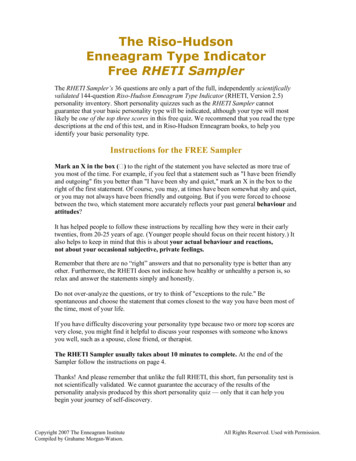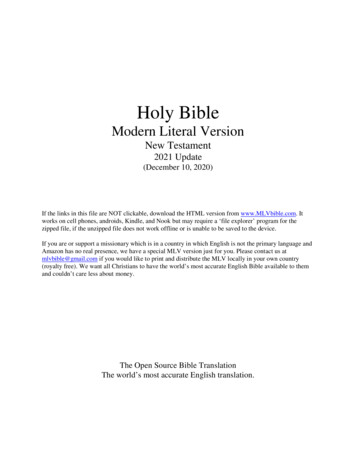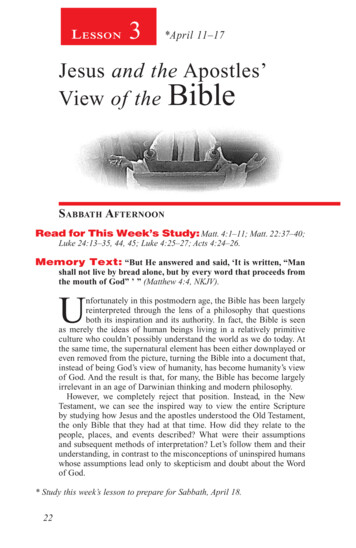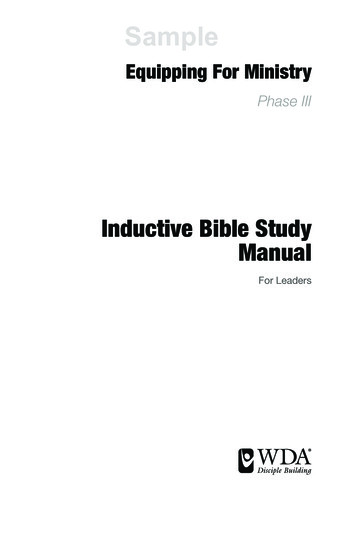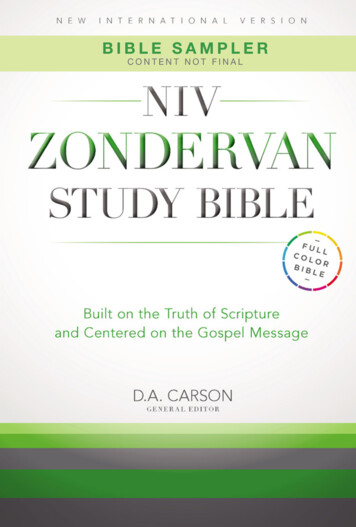
Transcription
B i b l e S a m p l erContent Not Final
n e wi n t e r n a t i o n a lv e r s i o nNIVZONDERVANStudy BibleBuilt on the Truth of Scriptureand Centered on the Gospel MessageD.A. Carsonge n e r a l E DI TOR
NIV Zondervan Study BibleCopyright 2014 by ZondervanAll rights reservedThe Holy Bible, New International Version , NIV Copyright 1973, 1978, 1984, 2011 by Biblica, Inc. Used by Permission. All rights reserved worldwide.Published by ZondervanGrand Rapids, Michigan, USAwww.zondervan.com“New International Version” and “NIV” are registered trademarks of Biblica, Inc. Used by permission.The NIV text may be quoted in any form (written, visual, electronic or audio), up to and inclusive of five hundred (500)verses without the express written permission of the publisher, providing the verses quoted do not amount to a completebook of the Bible nor do the verses quoted account for twenty-five percent (25%) or more of the total text of the work inwhich they are quoted.Notice of copyright must appear on the title or copyright page as follows:Scripture quotations taken from The Holy Bible, New International Version , NIV .Copyright 1973, 1978, 1984, 2011 by Biblica, Inc. Used by permission. All rights reserved worldwide.The “NIV” and “New International Version” are trademarks registered in the United States Patent and Trademark Office byBiblica, Inc. When quotations from the NIV text are used by a local church in non-saleable media such as church bulletins, orders ofservice, posters, overhead transparencies, or similar materials, a complete copyright notice is not required, but the initials(NIV ) must appear at the end of each quotation.Any commentary or other biblical reference work produced for commercial sale, that uses the NIV text must obtain writtenpermission for use of the NIV text.Permission requests for commercial use within the USA and Canada that exceeds the above guidelines must be directed toand approved in writing by Zondervan, 3900 Sparks Drive SE, Grand Rapids, MI 49546, USA. www.Zondervan.comPermission requests for commercial use within the UK, EU and EFTA that exceeds the above guidelines must be directedto and approved in writing by Hodder & Stoughton Limited, 338 Euston Road, London NW1 3BH, United Kingdom. www.Hodder.co.ukPermission requests for non-commercial use that exceeds the above guidelines must be directed to and approved in writingby Biblica US, Inc., 1820 Jet Stream Drive, Colorado Springs, CO 80921, USA. www.Biblica.comAny Internet addresses (websites, blogs, etc.) and telephone numbers in this Bible are offered as a resource. They are notintended in any way to be or imply an endorsement by Zondervan, nor does Zondervan vouch for the content of these sitesand numbers for the life of the Bible.All rights reserved.A portion of the purchase price of your NIV Bible is provided to Biblica so together we support the mission of Transforminglives through God’s Word.Biblica provides God’s Word to people through translation, publishing and Bible engagement in Africa,Asia Pacific, Europe, Latin America, Middle East, and North America. Through its worldwide reach, Biblicaengages people with God’s Word so that their lives are transformed through a relationship with JesusChrist.
INTRODUCTION TOtheLettersandRevelationRomans1 Corinth ians2 Corinth iansG alatiansEp h esiansPh ilip p iansColossians1 Th essalonia ns2 Th essalonia ns1 Timot h y2 Timot h yTitusPh ilemonHe bre w sJ ames1 Peter2 Peter1 J oh n2 J oh n3 J oh nJ udeRevelation
the Letters and RevelationDouglas J. MooLetters occupy an important place inthe NT. Of the 27 books of the NT, 21are letters — 35 percent of the NT. Bycontrast, no OT book is in the form ofa letter, though letters are preservedwithin those books.There are many reasons that letters loom so large in the NT, but threedeserve mention. First, letters were avery popular method of communication in the NT world (see New Testament Letters in Their Ancient Context).Second, the early Christian movementwas scattered across a wide area, andletters afforded a natural way forbelievers to keep in touch with eachother. Apostles, who are responsible forat least 19 of the 21 NT letters, traveledwidely and used letters as a means of“pastoring” churches from a distance.Third, and related to this second factor, the letter was considered a meansof establishing one’s personal presenceat a distance. When the apostles wereunable to assert their authority in person, they used letters as a “stand-in” fortheir presence (see 1 Cor 5:4; Col 2:5).NT letter writers, as we would expect,focus on issues relevant to their audiences. Spread across the eastern Mediterranean world, from modern Turkeyto Rome, Christians are thanked forsending gifts (Philippians), warnedabout false teachers (2 Peter, Jude),encouraged in the midst of persecution(1 Peter), and rebuked for dallying withidol worship (1 Corinthians). Yet thesefirst-century issues are addressed inthe light of God’s revelation of his Son.They have been preserved in our Biblesas enduring witnesses to the truth of thegospel and to the way that truth is toform the lives of God’s people.Classifying the New TestamentLettersThe 21 NT letters were written by sixdifferent early Christian leaders: 13letters are attributed to the apostlePaul; two to the apostle Peter; one toJames; and one to Jude, “a brother ofJames” ( Jude 1). No specific name isassociated with the four remaining letters. The author of Hebrews cannot beidentified. The author of 2 and 3 Johnis identified as “the elder” (2 John 1;3 John 1), and the similarities in styleand content with 1 John make it likelythat the same author is responsible forall three. As the titles in our Bibles suggest, John the son of Zebedee, one ofthe 12 apostles and the author of thefourth Gospel, is probably the writer ofthese three letters. (These titles indicatethe way these letters were viewed in theearly church, but the titles were notpart of the original NT text.)Hebrews and the General LettersPaul wrote 13 of the NT letters. Theremaining eight letters defy simpleclassification. Many Christians inthe first centuries of the churchthought that Paul wrote Hebrews, soit was included among the Paulineletters. The other seven letters ( James,1 – 2 Peter, 1 – 3 John, Jude) werethen categorized as “catholic” (in thesense of “universal”) or “general”letters because it was thought thatthey were written to the church as awhole (see Eusebius, EcclesiasticalHistory, 2:23 – 25). The titles given tothese books reflect this way of looking at them: rather than being namedaccording to their destinations or audiences, as in the case of all the Paulineletters and Hebrews, they are namedaccording to their authors.This traditional way of categorizing the letters does not stand up toscrutiny. Hebrews was almost certainlynot written by Paul (see Introductionto Hebrews: Author). Nor is it likelythat the remaining seven letters werewritten to the church “universal.”To be sure, none of them is explicitlyaddressed to a single local church (orgroup of house churches). But theydo have specific audiences in view.The letters of 2 – 3 John explicitlyaddress, respectively, a local church(taking “the lady chosen by God” inthis sense [2 John 1]) and a Christianleader (Gaius [3 John 1]). First Peteraddresses Christians living in fiveRoman provinces in northern AsiaMinor. Three of the letters, to be sure,have very general addressees. Jameswrites to “the twelve tribes” ( Jas 1:1),a reference to the people of God in theera of fulfillment; Peter writes in hissecond letter to “those who throughthe righteousness of our God and Savior Jesus Christ have received a faith asprecious as ours” (2 Pet 1:1); and Judewrites to “those who have been called,who are loved in God the Father andkept for J esus Christ” ( Jude 1). Butthe content of these letters shows thatthe authors are dealing with specificproblems that are probably confinedto a particular church or group ofchurches. The same is true of 1 John(which lacks any addressee).Paul’s LettersPaul, for his part, addresses nine ofhis letters to particular local churches,three to co-workers in ministry(1 – 2 Timothy, Titus), and one primarily to a co-worker and secondarily totwo other prominent believers and thechurch that met in his house (Philemon). Paul’s letters have usually beendivided into four main groups:1. Romans, 1 – 2 Corinthians, andGalatians have been labeled the “chiefletters” because of their length andtheological content.2. Ephesians, Colossians, Philippians, and Philemon are called the“prison letters” because Paul claims tobe “in chains” in each of them.
I n t r o d u c t i o n t o t h e L e t t e r s a n d R e v e l at i o n 5Crypt of Santa Maria in via Lata in Rome. This area was built in the firstcentury, but radically restructured in the third century. It is a possiblelocation for Paul’s house arrest. Lorenzo Pio Massimo Martino3. 1 – 2 Timothy and Titus are calledthe “pastoral letters” because of theircommon themes and the fact that theyare addressed to Paul’s co-workers.4. 1 – 2 Thessalonians comprise thefourth group.This traditional scheme corresponds generally to the historical circumstances in which the letters werewritten — with two exceptions. First,while Galatians shares many themeswith Romans, it may not come fromthe same period of time as the otherthree “chief letters.” Second, Philippians stands apart from the other prisonletters. The common themes and specific historical references common toEphesians, Colossians, and Philemonare absent from Philippians. WhetherPaul wrote Philippians at a differenttime during the same imprisonment asthe others or during a different imprisonment entirely is not clear.New Testament Letters in TheirAncient ContextThough letters were used as a means ofcommunication for centuries (see, e.g.,2 Sam 11:14 – 15; Ezra 4 – 5), it was inthe Greco-Roman world that lettersbecame an established and popularmethod of communication. The NT, aswe have seen, reflects this situation. Inaddition to the 21 canonical letters, theNT refers to at least nine other letterswritten by and to believers (Acts 15:23;18:27; 1 Cor 5:9; 7:1; 16:3; 2 Cor 2:3 – 4;Col 4:16 [two different letters are mentioned]; 2 Thess 2:2; note also the sevenletters to the churches in Rev 2 – 3).Introduction and ConclusionNT letters follow the general patternof the Greco-Roman letter, althougha servant of God and of the Lord JesusChrist” [Jas 1:1]) and of the recipients(e.g., “to God’s holy people in Colossae, the faithful brothers and sistersin Christ” [Col 1:1]). In Romans, Paulspends six verses introducing himself.On the other hand, some NT letters(Hebrews, 1 John) have no letter opening at all.In place of the usual “greeting”found in Greco-Roman letters, NTletters often include a “grace wish”(it is found in all the Pauline letters,1 – 2 Peter, and 2 John). The NT letterwriters may be indulging in a bit ofwordplay: Greek “greetings” is chairein,whereas Greek “grace” is charis.Ancient letters also often opened with a“health wish” (see 3 John 2); perhapsthe NT penchant for putting a thanksgiving (all the Pauline letters exceptGalatians, 2 Corinthians, 1 Timothy,and Titus) or blessing (2 Corinthians,Ephesians, 1 Peter) at the beginning ofletters reflects this practice.The concluding elements in theancient letter varied considerably,although they typically included arequest to greet other people. NT letterclosings often include such requestsfor greetings and, in addition, oftenmention travel plans, the movementsand work of other ministry workers,What is true concerning Paul’steaching about the law in Galatiansis true for many, if not most, of theissues discussed in the NT letters.there are differences. The typicalGreco-Roman letter was composed ofan address and greeting, a body, and aconclusion.The address and greeting were usually very short, typically taking theform “A to B, greetings.” NT letters tendto expand this formula, adding characterizations of the sender (e.g., “James,requests for prayer, and benedictionsand doxologies.BodyThe formal introduction and conclusion framed the letter body. Naturally,the letter body differed considerably inlength and substance, depending onthe purpose and audience of the letter.
6 I n t r o d u c t i o n t o t h e L e t t e r s a n d r e v e l at i o nSome ancient letters were very briefpersonal notes requesting information or asking someone to perform aspecific task. None of the NT letters isthis kind of private note. Even the letters written to individuals (1 – 2 Timothy, Titus, 3 John) deal with practicaland theological issues affecting otherChristians. At the other end of thespectrum, some ancient letters werewritten for a very general audienceand intended for wide distribution(somewhat comparable to our “letterto the editor”). Especially relevant forthe NT are letters sent by philosophersto communicate their teachings to awider audience. Some NT letters tendtoward this type (Romans, Ephesians,1 John). Yet even these more generallyfocused letters are written for specificaudiences.While using the popular letter formof their time, the writers adopt the formfor their own uses. For instance, manyof the NT letters stand out from theircontemporary secular models in length.Private letters in the ancient worldaveraged 87 words in length. Public letters were longer. Two of the most pro-lific letter writers in the ancient worldwere the Romans Cicero and Seneca.The former’s letters average 295 words;Seneca’s, 995. By contrast, the shortestNT letter (2 John) is 219 words, the longest (Romans) is 7,111 words, and theyaverage 2,141 words.Writing, Sending, and ReceivingNew Testament LettersCommunicating by letter writing inthe ancient world was a cooperativeenterprise. The first-person singularverbs scattered through all the NTletters make clear that one particularindividual is largely responsible foreach of them. However, Paul frequentlyincludes co-workers when he introduces the writers of his letters: Timothyin Philippians, Colossians, and Philemon; Timothy and Silas in 1 – 2 Thessalonians; and “all the brothers andsisters with me” in Galatians (1:2).Paul usually mentioned these coworkers because they were with himas he wrote and had significant contact with the believers being addressed.Mentioning other believers (as in thebroader group in Galatians) may alsostrengthen Paul’s appealin the letter by remindingthe recipients that he wasspeaking for a wider groupof believers.Producing letters wasalso a c ooperative venture. The parchment onwhich the words of letterswere physically recordedwas expensive, and mostancient letter writersdictated their letters to ascribe, or “amanuensis,”who was skilled at fittinga lot of words into a verysmall space. We have onedefinite reference to suchan amanuensis in theFourth-century relief of an orator dictatingNT: “I, Tertius, who wroteto a scribe. An amenuensis was often useddown this letter, greet youto produce letters in New Testament times,in the Lord” (Rom 16:22).including by Paul (Rom 16:22).Tertius recorded the wordsRelief depicting orator dictating to scribe, from Temple of Hercules atOstia Antica/De Agostini Picture Library/G. Dagli Orti/Bridgeman Imagesof Romans as Paul dic-tated them to him (many interpretersthink that 1 Pet 5:12 may also singleout Silas as the amanuensis of that letter). The actual “author” of the letterwould sometimes add a final, authenticating greeting in his own hand (seeGal 6:11; 2 Thess 3:17; Phlm 19). Mostof the NT letters were probably produced in this way. Authors who knewand trusted their amanuenses wouldoften entrust that amanuensis with theprecise wording of a letter. This mayexplain some of the variety in styleamong NT letters with the same author(Paul and Peter). We can assume thatNT authors took ownership of theirletters by checking them over to makesure that the amanuensis had accurately communicated the author’sintentions.If the writing of a letter was a collective enterprise, so was its delivery.Mail service was basically nonexistentin the ancient world. The only way toget a letter to its destination was toentrust it to a friend or associate whowas traveling to the destination of theletter. While never mentioned explicitlyin the NT, letter carriers can be identified by language such as we find in Eph6:21: “Tychicus, the dear brother andfaithful servant in the Lord, will tellyou everything, so that you also mayknow how I am and what I am doing.”Col 4:7 is similar; see also Phoebe inRom 16:1 – 2, Epaphroditus in Phil2:25 – 30, and Silas in 1 Pet 5:12 (ifhe is not the amanuensis; see preceding paragraph). These letter carriersprobably also played a significant rolein the dissemination of the letter onceit reached its destination. They wouldoften be the ones to read the letter tothe assembled congregation, addinginformation and perhaps clarificationalong the way (see Eph 6:21, quotedabove, and also Col 4:7 – 9).The Authenticity of NewTestament LettersMany books in the ancient world werewritten by an anonymous person inthe name of a more famous person. A
I n t r o d u c t i o n t o t h e L e t t e r s a n d R e v e l at i o n 7Jewish apocalyptic work from the firstcentury AD, for instance, is attributedto the ancient Israelite scribe Ezra.Many modern scholars identify thisphenomenon, called “pseudepigraphy,” in the NT letters. It is typical, forinstance, to claim that the apostle Paulhimself actually wrote only seven ofthe thirteen letters attributed to him(Romans, 1 – 2 Corinthians, Galatians,Philippians, 1 Thessalonians, and Philemon) and that Paul’s followers wrotethe other six letters in his name. Simi-lar doubt is cast on the authorship ofJames and 1 – 2 Peter. According to oneform of this theory, the authors whowrote in the name of the apostles werenot being deceptive but simply usinga standard literary device of the timeto communicate Christian truth. However, while pseudepigraphy in generalwas widespread in the ancient world,the writing of letters in someone else’sname did not often take place. Andwhen it did, the practice was frownedupon. The church fathers are veryclear on this point: they viewed writing a letter in someone else’s name asinherently deceptive, and they roundlyrejected any letter suspected of beingpseudepigraphical. In light of this attitude, we should take the claims aboutauthorship of NT letters at face value.Interpreting New TestamentLettersOccasionNT letters are “occasional,” i.e., theyare written to a particular first-centurySummary of the New Testament LettersLetterAuthorRecipientsPlace of WritingDateJamesJames,brother of the LordJewish believers living outsideof IsraelJerusalem45 – 48(or 60s)First MissionaryJourneyGalatiansPaulBelievers in the Romanprovince of Galatia orBelievers in the ethnic regionof GalatiaAntioch orEphesus (?)48(or 51 – 52or 54 – 55)SecondMissionaryJourney1 ThessaloniansPaulBelievers in ThessalonicaCorinth50 – 512 ThessaloniansPaulBelievers in ThessalonicaCorinth50 – 511 CorinthiansPaulBelievers in CorinthEphesus54 – 552 CorinthiansPaulBelievers in CorinthMacedonia55 – 56RomansPaulBelievers in RomeCorinth57EphesiansPaulBelievers in Ephesus (and innearby cities)Rome60 – 61ColossiansPaulBelievers in ColossaeRome60 – 61PhilemonPaulPhilemon, a ministry co-workerin Colossae, and the church thatmet in his homeRome60 – 61PhilippiansPaulBelievers in PhilippiRome (or Ephesus?)62 (or 54 – 55)1 TimothyPaulTimothy, a ministry associateworking in EphesusMacedonia (?)62 – 63TitusPaulTitus, a ministry associateworking in CreteUnknown62 – 632 TimothyPaulTimothy, a ministry associateRome64 – 65 (or 67)HebrewsUnknownBelievers in Rome (?)Unknown60s1 PeterThe apostle PeterBelievers in northern Asia MinorRome (?)60 – 632 PeterThe apostle PeterBelievers in northern Asia MinorUnknown63 – 65JudeJude, a brother of JamesUnknownUnknownLate 50s tolate 60s1 JohnThe apostle JohnBelievers in Ephesus andsurrounding regions (?)Ephesus (?)Early 90s2 JohnThe apostle JohnA church in the region ofEphesusEphesus (?)Early 90s3 JohnThe apostle JohnGaius, a ministry co-workerEphesus (?)Early 90sThird MissionaryJourney
8 I n t r o d u c t i o n t o t h e L e t t e r s a n d r e v e l at i o naudience and therefore naturallydeal with issues relevant to that audience. Because the NT letter writers areengaged in helping their recipientsunderstand the significance of Christ’scoming and put into practice the implications of his lordship, the issues theNT deals with are often the same issuesChristians face today. But even whenthose issues are the same, faithfullyinterpreting the NT letters demandsthat we take into account the occasional nature of those letters.Paul’s teaching on the significanceof the law of Moses in Galatians provides a good example. His teachingon this issue is clearly of enduringrelevance, and what he says on thismatter must figure importantly in ourattempt to understand the place of thelaw of Moses in the history of salvationand in the life of the church. But wemust also recognize that Paul writes tothe Galatians about the law of Moseswith a particular purpose: to convincethem not to follow false teachers whohave taken a wrong view about the law.Because Paul is refuting a particularviewpoint, his teaching is inevitablyslanted to one side of the issue.What is true concerning Paul’s teaching about the law in Galatians is true formany, if not most, of the issues discussedin the NT letters. Many of these letterswere written directly to counter somekind of false teaching, and what the NTletter writers say is tailored to that situation. To read and interpret these lettersrightly, then, requires that we understandthe situations in which they were written;this information is provided in this studyBible’s separate book introductions. Atthe same time, we must always compareScripture with Scripture before drawingbroad conclusions about what the NT orthe Bible says about any particular topic.Social and Cultural ContextThe occasional nature of the NT letters provides another interpretivechallenge: recognizing how the firstcentury social and cultural contextmight affect our reading. Both thewriters and readers of the NT lettersoften simply assumed this context, butit is sometimes utterly foreign to modern readers. For example, just whatwere the women in Corinth doing thatupset Paul (1 Cor 11:2 – 16)? Werethey refusing to wear a veil over theirheads? Were they refusing to “put theirhair up” on their heads? And, in eithercase, why would Paul have a problem with it? Only by understandingthe culture of that day can we hopeto accurately understand what Paulis teaching in this passage. Faithfullyreading the NT letters will often, then,require the believer to learn somethingabout the first-century world — aninquiry that the notes on particularpassages in this study Bible shouldassist with.General PrinciplesWhatever the particular issue a NTletter deals with, the way in whichthe author responds to it has much toteach us. We learn not only from thespecific instructions the letter writersgive but also from the general principles they constantly bring to bear oneach issue they confront. Again andagain the NT letter writers remind usof the all-encompassing importanceof the lordship of Christ and the workof the Holy Spirit. The believer’s everythought and action must be subjectedto Christ, who as Lord wants to reignover every facet of the believer’s life.And it is the Holy Spirit who bothempowers and guides this radicallyChrist-centered new life. When the NTletter writers call on believers to thinkand act in accord with the person ofChrist, they expect believers to respondbecause God has sent his Spirit intothe hearts of his people, producingfrom within the attitudes and perspectives that will enable them to obey. As“occasional” letters, we must read eachNT letter against the background of itsparticular setting, asking: when was itwritten? for whom? why? in what circumstances? But at the same time, Godhimself speaks to us in and throughthese occasional letters. As canonical Scripture, these letters ultimatelyaddress the church of every age and ofevery place. nStatue of woman wearing a chitonand himation, 1st century AD. Itis important to understand thecultural context of Paul’s commentson covering the head in worship(1Cor 11).Kim Walton, courtesy of the National ArchaeologicalMuseum of Athens
Introduction toRomansAu th o rThe letter to the Romans was written by the apostle Paul (1:1). No coauthor is mentioned, although Tertius was theman who served as Paul’s scribe, or amanuensis, writing down Paul’s words as he dictated them (16:22).Oc c a s i o n , D at e , a nd Pl a ce of W r i t i ngPaul gives us considerable information about his situation in 15:14 – 33. He suggests that he has reached an important turning point in his ministry. He speaks of having “fully proclaimed” the gospel “from Jerusalem all the wayaround to Illyricum” (15:19) — the territory where he planted vibrant churches during his first three missionaryjourneys. The next focus of his missionary effort is all the way at the other end of the Mediterranean basin: Spain(15:24). Before going to Spain, however, he has two important stops to make. His immediate plans are to travel toJerusalem in order to deliver to the Jewish Christians there some money from many of the Gentile churches he planted(15:25 – 27). After Jerusalem, Paul hopes to pass through Rome to visit this important center of Christianity and toenlist their support for his new missionary venture (15:23 – 24). When we add to this information Paul’s reference toa woman from Cenchreae (16:1), a city very close to Corinth, the setting of Romans becomes pretty certain: he waswriting from Corinth during his three-month stay there toward the end of his third missionary journey (Acts 20:3 – 4).At lant icLocationsVisited by PaulOc eanSIdriaanaSeaPhilippiNicomediaThessalonicaSmyrna ThyatiraSardisCorinth Athens EphesusCarthageFRICAE G Y P TTyreJoppaDamascusJerusalemhrp300 milesAAntiochEu0300 km.AlexandriaTarsusrisCyreneIconiumTi gKnossosMeCRditETEerranean Sea0ASIAESeBlack SeacECNeapolistiGREniLYrheANrTyIRomeATPAates
10 Introduction to RomansThe date of this stay was probably AD 57. Romans, then, was the third letter Paul wrote on this missionary journey(after 1 Corinthians in perhaps AD 54 and 2 Corinthians in AD 55 – 56).RecipientsPaul writes to all the believers in the city of Rome (1:7). The NT tells us nothing about how Christianity first came toRome, but a plausible scenario is that Jewish believers who were present in Jerusalem on the day of Pentecost (Acts2:10 says that “visitors from Rome” were there) brought their new faith back to their home city. The early Christiangiven the name Ambrosiaster (late fourth century), then, was probably right in claiming in his commentary on Paul’sletters that the Romans “embraced the faith of Christ, albeit according to the Jewish rite, without seeing any sign ofmighty works or any of the apostles.”Several passages in Romans suggest, however, that most of the Roman Christians were Gentiles when Paul wrote(1:6 – 7,13; 15:15 – 16). Some Gentiles were probably attracted to the faith from the beginning, having heard aboutthe message of Jesus as “God-fearers” (Gentiles who attended the synagogue without converting to Judaism). TheGentile element in the Roman church received a significant boost in AD 49 when Claudius expelled all the Jews fromRome (see Acts 18:2). Jewish Christians would have been included in this eviction order, so the Christian movementwould have become almost entirely Gentile overnight. By the time Paul wrote the letter to the church in Rome,however, Jews had been allowed back into the city. Thus, Paul’s audience included Jewish Christians such as Priscillaand Aquila (16:3 – 5; cf. Acts 18:2).P u rp o s ePaul has several purposes in writing to the Romans.1. Paul hopes to enlist the support of the Roman Christians for his new ministry in Spain (15:24). Spain is a longway from his original “sending” church in Antioch, and he needs a ministry base closer to Spain to provide monetaryand logistical support. Paul writes Romans, then, partly to introduce himself to a church that he did not found andhas never visited (1:13; 15:22).2. While Romans is justly famous for its deep theology, Paul is also concerned, as he is in all his letters, to addressthe situation of his readers. Of course, we must avoid the mistake of thinking that very deep theology might not be ofvery fundamental practical importance! But 14:1 — 15:13 reveals that Paul does have an eye on a particular issuein Rome. The believers are divided into two factions, which Paul labels the “weak” in faith and the “strong” in faithThe Forum: the economic, social, religious and cultural center of ancient Rome. ROMAOSLO/www.istock.com
Introduction to Romans 11(15:1). These factions were quarreling over whether Christians must continue to observe certain Jewish practicesderived from the law of Moses. Paul hopes to heal this unfortunate division.3. The conflict between the “weak” and “strong” in Rome was a microcosm of the major theological issue in Paul’sday. As the Christian movement became increasingly Gentile over the decades, the relationship between Christianityand its OT and Jewish roots became more and more controversial. Some, mainly Jewish Christians, were arguing fora great deal of continuity: Christians were a Jewish Messianic sect that should continue to observe the law of Moses(this was the view of the “agitators” whom Paul combats in Galatia [Gal 5:12]). Others, mainly Gentile Christians,wondered why they should have anything to do with the OT or the law at all. As Paul writes to the Romans aboutthe division there between these two general positions, he develops a theology of universal significance that seeks amiddle position between these views.M ajo r T h e m e sRomans is one of the most important t
book of the Bible nor do the verses quoted account for twenty-five percent (25%) or more of the total text of the work in which they are quoted. Notice of copyright must appear on the title or copyright page as follows: Scripture quotations taken from The Holy Bible, Ne
